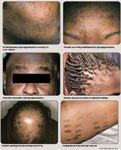- Case-Based Roundtable
- General Dermatology
- Eczema
- Chronic Hand Eczema
- Alopecia
- Aesthetics
- Vitiligo
- COVID-19
- Actinic Keratosis
- Precision Medicine and Biologics
- Rare Disease
- Wound Care
- Rosacea
- Psoriasis
- Psoriatic Arthritis
- Atopic Dermatitis
- Melasma
- NP and PA
- Skin Cancer
- Hidradenitis Suppurativa
- Drug Watch
- Pigmentary Disorders
- Acne
- Pediatric Dermatology
- Practice Management
- Prurigo Nodularis
- Buy-and-Bill
Article
Nuances of treating black skin
Black skin has a number of structural and functional differences compared to Caucasian skin. Dermatologists also need to keep cultural differences in mind when treating black patients.

Key Points

There are a number of structural, functional and cultural differences in black-skinned patients. Some of these impact the epidemiology and clinical presentation of skin disorders, says Andrew Alexis, M.D., M.P.H., dermatologist, assistant clinical professor of dermatology at Columbia University College of Physicians and Surgeons. Dr. Alexis is also director of the Skin of Color Center at St. Luke's Roosevelt Hospital.
While black skin can present in a range of shades, most black patients fall within Fitzpatrick skin types IV, V and VI.
Acne vulgaris is the most common disorder that Dr. Alexis and his colleagues treat among black patients at the Skin of Color Center.
The most notable difference among blacks with acne compared with whites is the presence of postinflammatory hyperpigmentation (PIH).

Dr. Alexis also addresses things that black patients might be doing at home that could exacerbate their acne.
A particularly common practice in the black community is the use of greasy hair care products that can result in pomade acne.
Dr. Alexis suggests that patients opt for silicone-based hair products, which are less likely to worsen acne.
Blacks also commonly apply cocoa butter to their faces to even skin tone. Within some African immigrant groups, steroid-containing fade creams are also sometimes used to lighten the skin.
"It is important to eliminate these exacerbating factors," Dr. Alexis tells Dermatology Times.
Another condition that has unique features in black skin is seborrheic dermatitis, which, in skin of color, can present as hypopigmentation, without the usual features of erythema and scaling.
Treatment, according to Dr. Alexis, is the same as it is in any ethnicity, with topical antifungal or topical steroid formulations. The only nuance, he says, is that black women typically wash their hair once a week or every other week, so dermatologists should consider recommending that they use medicated shampoos once a week.
CCCA, a unique disorder
Central centrifugal cicatricial alopecia (CCCA) is a disorder that almost exclusively affects people of African descent.
Dermatologists most commonly see it in women, and it often begins as a patch of hair loss on the crown of the scalp, spreading outwardly.
The cause is not clear, but researchers suspect the culprit may be hair care practices, including the long-term use of chemical relaxers, hot combs and other forms of heat to straighten the hair, according to Dr. Alexis.
"It is important to catch CCCA early because it is a scarring form of hair loss. Left to progress over a long period of time without treatment, there can be end-stage scarring, at which point there is very little one can do to reverse the process," he says.
Dr. Alexis recommends wigs and hair transplantation for end-stage CCCA, but says there are treatment options while the disease is active and still progressing.





